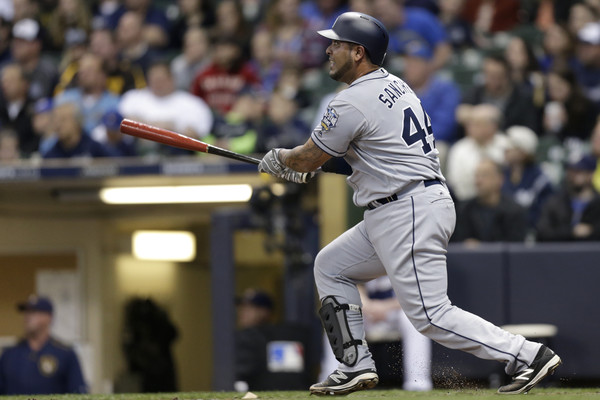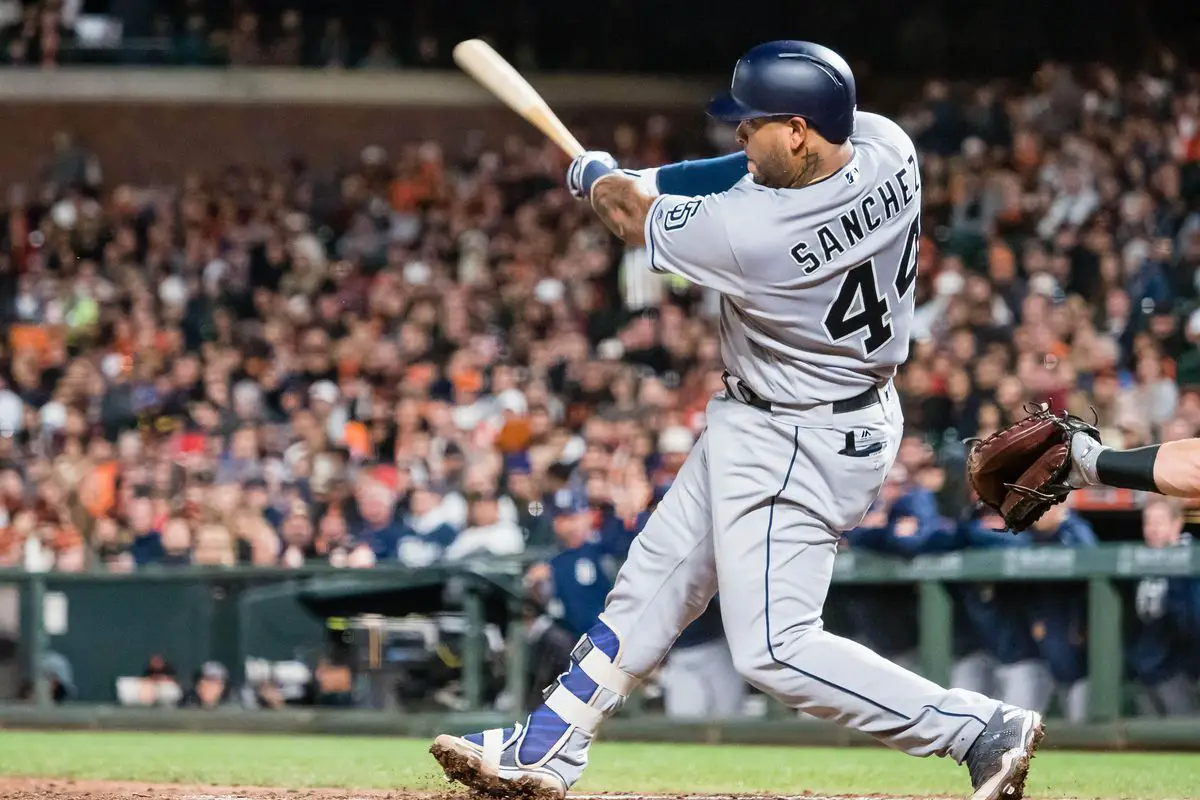PNO (Positive, Negative, Outlook): Hector Sanchez

Credit: AP Photo

Granted free agency on December 2, 2016, former San Francisco Giant Hector Sanchez was ready to contribute for another team in 2017.
However, San Diego would not let their solid backup catcher leave, as Preller resigned the 27-year-old for an extremely affordable $750,000 year, and an arbitration period arising next year. With his inclusion on the Padres’ active 25-man roster, the city carried a shocking four catchers: Austin Hedges, Luis Torrens, Christian Bethancourt, and Hector Sanchez.
As you may surmise by the way I ordered the catchers, Sanchez was still an afterthought, easily lost in the depth chart. Yet he still worked hard for a good season and provided meaningful innings behind the plate. By the time summer came, the veteran catcher became Hedges’ secondary, especially once Bethancourt was sent down to Triple-A on April 25 to become a better reliever. While he wasn’t a standout receiver, as evidenced by his harsh -.5 WAR, he showed excellent potential.
As a result, this piece will focus on his positives, negatives, and future outlook in an attempt to uncover what value he could have. Hopefully with such description, it becomes clear that investing in the Venezuelan is a good move for a club trying to replicate the Astros’ success.
Positives
Emerging Power
While his .219 batting average and .245 on-base percentage were very underwhelming, Hector Sanchez at least showed a knack for getting extra base hits. Prior to this season, the highest amount of home runs he swatted in a season was three and the highest number of extra base hits he gathered was eighteen. Those stats came from his 2012 campaign, when he was sent to the batter’s box 227 times. In 81 fewer at-bats, the switch-handed swinger improved with five additional round trippers and just six fewer extra base knocks. This was the result of him lowering his GB/FB ratio from 1.28 to .81 through the years. In other words, he adjusted his swing so that he could put more balls in the air and give himself more opportunities to exemplify strength.
The most exciting part of Sanchez’ power was his clutch talent. He utterly wrecked the spirits of N.L. West foes on numerous occasions. On April 30, he took Giants’ closer Mark Melancon deep as a pinch-hitter in the ninth. By doing so, he kept the Friars alive in a previously 2-0 game and paved the way for a San Diego victory. It took 12 innings to finish the battle, but without the catcher’s contributions, the club would have packed their bags much sooner. On June 30, Sanchez provided excitement again. With a 2-0 count against Sergio Romo, the veteran provided hope for a rally. While his depositing of a fly ball into the right field stands did not completely erase the eight-run differential the Dodgers possessed, his work did give fans a reason to hope. A noteworthy piece of information that arose from the situation was that the Venezuelan swung at a first-pitch strike. On the season, SD hitters were among the most inefficient at taking advantage of favorable counts. It became frustrating to watch players watch perfect balls pass them by and see them struggle to catch up to following ones. Yet, Hector Sanchez would have none of that foolishness this night. Instead, he used the 85 mph changeup given to him and saw it soar off his bat.

Lastly, on July 15, the Padres’ catcher took the place of late scratch Austin Hedges. This would turn out to be a wise decision by manager Andy Green as he added to San Diego’s win total by replacing his primary for the night. In a riveting ninth that I was fortunate to watch in person, Sanchez smashed a pitch off the Giants’ relief corps again, but this time won the game as a result. With his work, the Padres overcame San Francisco, and reliever Steve Okert, 5-3 in an epic home game. In short, this veteran at the very least could be a valuable source of power late in games. His bat might not be dangerous over a full season’s worth of appearances, but is definitely so in short spurts.
Reliable Defense
Throughout his time in the majors, Hector Sanchez has proved to be a sure-handed defender. He’s very similar to Yangervis Solarte in respect to how his fielding is merely average, but he gives his best each day, just like the Padre fan favorite/heart and soul player. His arm is well below average as evidenced by his 20% caught stealing rate, but his ability to block pitches is superb. In 163.2 innings receiving, there were only two balls that made it past Sanchez. Whereas this unique factor can be attributed to the mere size of the 27-year-old (6’0″ and 235 lbs.), the fact that he arrived at a positive mark (.1) on defense can’t. Usually a big player is forced to move to another position, often first base, because their relative lack of athleticism demands such a transition.
Just take Austin Allen, a promising power hitter in the Padres’ prospect pipeline, who has struggled to create a long-term future at position due to size concerns. Yet, there’s no reason to suggest that Sanchez has to be moved. In fact, his skills could have been improperly utilized for the first time this year. Prior to 2017, the Padre had been quite consistent at providing above .5 defensive value per season. In 2012, he even had a mark of 1.8, a figure influenced heavily by his stellar blocking ability. In 441 frames, he allowed just three pitches to get past him. This indicates that with more playing time, Sanchez could have the potential to be a solid backstop.
PAGE 2 LINK BELOW
I write, I write, and then I write some more.. Lifelong Padres & Chargers fan who is tired of the acceptance of losing that grips all of San Diego sports fans!